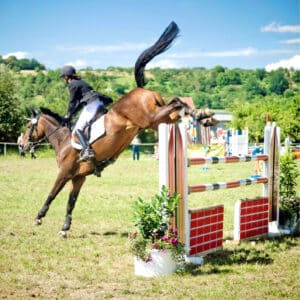Does your horse need to stretch? Leny Beahan talks to CHRISTINE ARMISHAW about the many benefits of stretching it out.
Leny Beahan has always been a lover of animals, particularly horses. As a child, her perception of horses was mixed: on the one hand, they seemed to be huge and rather scary animals, but on the other, she felt that they were also peaceful and intriguing, with an energy that for her, was magnetic.
Leny’s parents were not horsey, but, kind enough to indulge her fascination, they sent her to a local camp and riding school where she was able to spend time surrounded by horses. “I saved up and purchased my own horse as soon as I was able to and progressed from there,” Leny recalls. “Now I am a qualified equine bodyworker where I use various modalities to help horses feel their best.”
Interestingly, Leny has a background in soft tissue work with humans, who, because they could offer feedback, helped her refine her skills – and that has given her a great feel for how soft tissue should and shouldn’t feel in horses. “I also used to be a long distance runner and understand first-hand how bodywork helps with performance and recovery, which is how I started to wonder how I could apply my knowledge to my horses to help them perform better and recover quicker,” she explains.

Why stretch?
Leny uses a wide range of therapeutic modalities, including massage, mobilisation and stretching, biokinetic work, trigger point therapy, Emmett therapy, gait analysis and biomechanics. She feels that all types of therapies are great and have different focuses. “It’s super important for bodyworkers to stay within their scope of practice, and if they are in it for the benefit of the horse, then your therapist will have no hesitation in recommending another modality or therapist if needed,” says Leny.
Honing in on stretching, she emphasises the importance of first knowing what a stretch is, what stretching does, when and went not to use stretches and, of course, how to do them. “A stretch is a physical movement where we can improve muscle elasticity through elongation and lengthening to realign and reaffirm muscle tone and comfort, which is very beneficial when applied correctly.”
Stretching helps horses with their range of motion, improves stride length and increases flexibility, which results in better movement overall. And there are more benefits to be had: “Stretching also improves posture, stretches the fascia, and creates body awareness via neuromuscular pathways in the form of proprioception,” she adds, “so the horse has greater awareness when doing things like jumping and trail riding.” The pay-offs continue, with stretching helping to improve circulation by allowing blood to flow easily, easing pain by releasing endorphins, reducing muscle tension and spasm, helping to prevent injury by strengthening supportive and surrounding tissue and structures, and reducing any muscle soreness following an increase in activity or training.

Jumping creates a lot of downward force on the front of the body during landing.
Stretching correctly
Like anything, it’s important to make sure you stretch your horse correctly and to keep your end goal in mind. “It’s always a good idea to reach out to your professional and see what’s suitable for your particular horse because, while stretching has so many wonderful benefits, there are instances where horses would not be helped,” Leny tells me. She gives the example of hypermobile horses, who would benefit from strengthening exercises rather than stretching. Neither is stretching the right thing to do when there is an injury, an undiagnosed lameness, nerve pain, or if the horse is unwell. “When you do stretch, you also want to avoid holding tendons, and not make any strong, fast movements,” she adds.
And it’s wise to keep both your own and your horse’s safety in mind. For example, never hard tie your horse while performing any stretching. “Some horses may not be used to stretching and may dislike it or be unsure initially, or they may be really good at following your feel and drop down onto their knee,” she explains, these reactions making hard tying potentially hazardous. “You can also keep an eye on their facial expressions as an indicator of how they are feeling during the process.”
Knowing what’s normal and abnormal for your horse before stretching is always a good place to start. “If you do feel like your horse has a problem, then get advice first,” Leny says, adding that you also need to keep your own body position safe by using your knees and legs to take the weight off your back.
To stretch or not
So, how can you tell if a horse is lacking in mobility or if they would benefit from ground based stretches? Leny suggests a visual evaluation, paying attention to symmetry and evenness. “You want to look out for any changes in things like the normal stride length, whether the muscles look even on both sides of the body, and if they appear smooth when you look at them,” she suggests.

Western sports can require controlled strength, explosive movement and fast turns, with the horse sometimes needing to squat very low.
She lists some useful points to check off while performing your assessment: Can you see individual muscle outlines, or do they blend harmoniously? Do the muscles feel really hard or tight under your hand? Is the back contracted and the belly sunken down? Is the neck more developed underneath? Is there a dip where the neck and wither meet? Are the back muscles under-developed behind the wither where your saddle sits? Do you notice any muscle spasm when you touch the back? Do you notice any changes in your horse’s stability? “These are some of the things that may indicate you need to stretch and strengthen your horse,” she says.
If you’ve ascertained some stretching is in order, the next question is how often stretches need to be done to be truly beneficial, and Leny believes that for basic maintenance three times a week is great.
Getting sport specific
Over all, horses use their entire body when any sort of riding activity is asked of them, but here Leny gets a little more discipline specific. Jumping creates a lot of downward force on the front of the body during landing, placing strain on the pectorals and shoulder girdle muscles, as well as the foreleg tendons. Equally, a lot of force is required for the explosive movement of pushing off and lifting up to jump. In the push-off phase, the horse uses the glutes, quadriceps, hamstrings, hip flexors, and their back, so stretching these muscles can be very beneficial.

Safety first – never hard tie your horse, and bend your knees to protect your back.
Dressage requires strength and suppleness and is very physical so, while the whole body is utilised, it is the poll, neck, back, abdominals and hind quarters that are especially involved. Western sports can require either controlled strength or explosive movement and fast turns, with the horse sometimes needing to squat very low. This requires enormous amounts of muscle and energy in the pelvis, glutes, hocks, hamstrings, hip flexors and the back, so working on these areas can be of great help. “But really, any ridden horse will enjoy the myriad of benefits to be gained through stretches over the whole body,” Leny adds.
No matter what the discipline or the activity level, and even for horses who are inactive or retired, the wonderful benefits of stretching regularly are similar for any horse.
In the second part of this series Leny explains the three different types of stretches, and the one she loves above all others. To learn more about Leny’s work, visit Connected Equine.
Feature Image: A lot of force is behind the explosive movement of pushing off for a jump (Image by Jessica Morton).



